Indianapolis Public Schools may open a new magnet school on the north side, a move that would further cluster sought-after programs in one of the district’s most affluent areas.
The school board heard a proposal Tuesday to convert School 55, also called Eliza Blaker, to the second lab school in collaboration with Butler University. If the board approves the plan, current students would have the choice to remain at the school, but new children would be admitted by lottery.
It would mean that in the area north of 46th Street along the College Avenue corridor — which encompasses some of the city’s most affluent neighborhoods as well as some lower income neighborhoods — every elementary school would be a magnet.
The district is making progress in a campaign to increase diversity in the most sought-after programs. But the decision to place another magnet school on the north side is likely to draw criticism from parents who would like to see them in other areas.
These schools are “concentrated,” said board member Kelly Bentley, who represents the area around School 55. “We are 80 square miles, and yet, those programs are all isolated in a less than 10 square mile area of our district.”
“We’ve got a big district out there, and there are areas that I think could really benefit from some of these programs,” she added.
Indianapolis Public Schools elementary campuses
If the IPS administration converts School 55 to magnet school, it will increase the cluster of magnet programs on north side of the district. Most elementary schools on the east, south and west sides of the district are traditional neighborhood schools. (The map shows traditional, magnet and innovation conversion schools. It does not include other schools in the innovation network.)
The district currently operates School 60, which is about 3 miles south of School 55, as a lab school in collaboration with Butler. The school is open to students from across the district, but families who live nearby and children with parents who work at Butler have an advantage in the magnet lottery. As a lab school, it’s also a place where Butler education students gain on-the-ground experience through classes and as teaching assistants.
That’s one reason why the proposal calls for locating the second magnet campus on the north side: There are other locations that might be a good fit, but students from Butler need to be able to get to and from the campus for classes, said school leader Ron Smith. “A Butler lab school does need to be near enough … to make it a viable option for coursework.”
The school uses the Reggio Emilia educational philosophy. Like Montessori schools, Reggio emphasizes hands on learning and allowing students to choose what they study. School 60 has some multigrade classrooms and some that are single grades as part of the experimental approach of a lab program, which aims to test out educational ideas. It is one of the most popular schools in the district and last year, 266 applicants were placed on the waitlist.
When the Butler lab program began at School 60 about five years ago, most of the prior students were forced to leave, and the school restarted by building up from the early grades.
The new magnet dramatically altered the makeup of the school. Before the lab program began, School 60 educated a heavily black, low-income population. Nearly 92 percent of students were black, and more than 85 percent were poor enough to receive subsidized lunch. Since becoming a magnet, the school’s enrollment has transformed: Last year, 62 percent of students were white and 28 percent were eligible for subsidized meals.
But Smith said the picture is beginning to look different this year. With the help of new district admissions policies aimed at diversifying magnet schools and outreach from current parents, who have hosted events and gone door-to-door to recruit families, Smith said, the school has enrolled substantially more children of color.
If the board approves the proposal, School 55 would likely see a less dramatic shift in demographics because all of the current students would be able to remain. The campus is only about half full, so it could absorb some new students without displacing any of the current children.
The new campus could help diversify the program, said Smith: “It’s our intention that every family currently at School 55 would choose to remain as a part of the lab school program.”
Update: This story has been updated to clarify that the only innovation schools that appear on the map are conversion schools.

